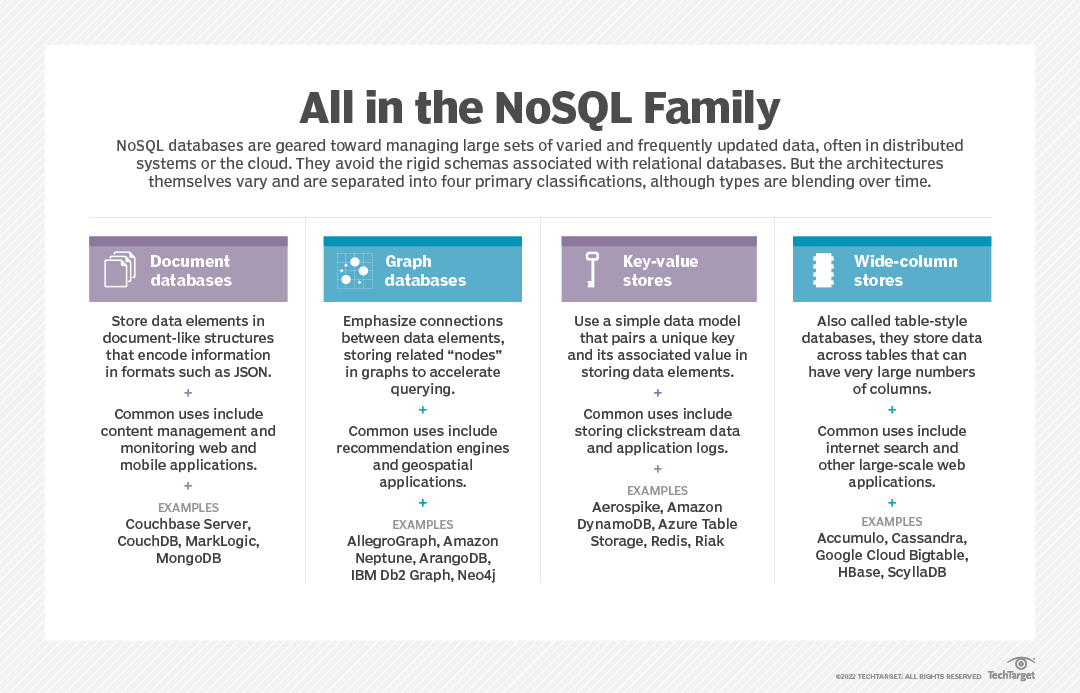NoSQL (Not Only SQL database)
NoSQL is an approach to database design that can accommodate a wide variety of data models, including key-value, document, columnar and graph formats. NoSQL, which stand for "not only SQL," is an alternative to traditional relational databases in which data is placed in tables and data schema is carefully designed before the database is built. NoSQL databases are especially useful for working with large sets of distributed data.
NoSQL vs. RDBMS
The NoSQL term can be applied to some databases that predated the relational database management system, but it more commonly refers to the databases built in the early 2000s for the purpose of large-scale database clustering in cloud and web applications. In these applications, requirements for performance and scalability outweighed the need for the immediate, rigid data consistency that the RDBMS provided to transactional enterprise applications.
Notably, the NoSQL systems were not required to follow an established relational schema. Large-scale web organizations such as Google and Amazon used NoSQL databases to focus on narrow operational goals and employ relational databases as adjuncts where high-grade data consistency is necessary.
Early NoSQL databases for web and cloud applications tended to focus on very specific characteristics of data management. The ability to process very large volumes of data and quickly distribute that data across computing clusters were desirable traits in web and cloud design. Developers who implemented cloud and web systems also looked to create flexible data schema -- or no schema at all -- to better enable fast changes to applications that were continually updated.

Key-value stores
Key-value stores, or key-value databases, implement a simple data model that pairs a unique key with an associated value. Because this model is simple, it can lead to the development of key-value databases, which are extremely performance and highly salable for session management and caching in web applications. Implementations differ in the way they are oriented to work with RAM, solid-state drives or disk drives. Examples include Aerospike, Berkeley DB, MemchacheDB, Redis and Riak.
Document databases
Document databases, also called document stores, store semi-structured data and descriptions of that data in document format. They allow developers to create and update programs without needing to reference master schema. Use of document databases has increased along with use of JavaScript and the JavaScript Object Notation (JSON), a data interchange format that has gained wide currency among web application developers, although XML and other data formats can be used as well. Document databases are used for content management and mobile application data handling. Couchbase Server, CouchDB, DocumentDB, MarkLogic and MongoDB are examples of document databases.
Wide-column stores
Wide-column stores organize data tables as columns instead of as rows. Wide-column stores can be found both in SQL and NoSQL databases. Wide-column stores can query large data volumes faster than conventional relational databases. A wide-column data store can be used for recommendation engines, catalogs, fraud detection and other types of data processing. Google BigTable, Cassandra and HBase are examples of wide-column stores.
Graph stores
Graph data stores organize data as nodes, which are like records in a relational database, and edges, which represent connections between nodes. Because the graph system stores the relationship between nodes, it can support richer representations of data relationships. Also, unlike relational models reliant on strict schemas, the graph data model can evolve over time and use. Graph databases are applied in systems that must map relationships, such as reservation systems or customer relationship management. Examples of graph databases include AllegroGraph, IBM Graph, Neo4j and Titan.
Evolution of NoSQL
Berkeley DB was an influential system in the early evolution of NoSQL database usage. Developed at the University of California, Berkeley, beginning in the 1990s, Berkeley DB was widely described as an embedded database that closely supported specific applications' storage needs. This open source software provided a simple key-value store. Berkeley DB was commercially released by Sleepycat Software in 1999. The company was later acquired by Oracle in 2006. Oracle has continued to support open source Berkeley DB.
Other NoSQL databases that have gained prominence include cloud-hosted NoSQL databases such as Amazon DynamoDB, Google BigTable, as well as Apache Cassandraand MongoDB.
The basic NoSQL database classifications are only guides. Over time, vendors have mixed and matched elements from different NoSQL database family trees to achieve more generally useful systems. That evolution is seen, for example, in MarkLogic, which has added a graph store and other elements to its original document databases. Couchbase Server supports both key-value and document approaches. Cassandra has combined key-value elements with a wide-column store and a graph database. Sometimes NoSQL elements are mixed with SQL elements, creating a variety of databases that are referred to as multimodel databases.
No comments:
Post a Comment